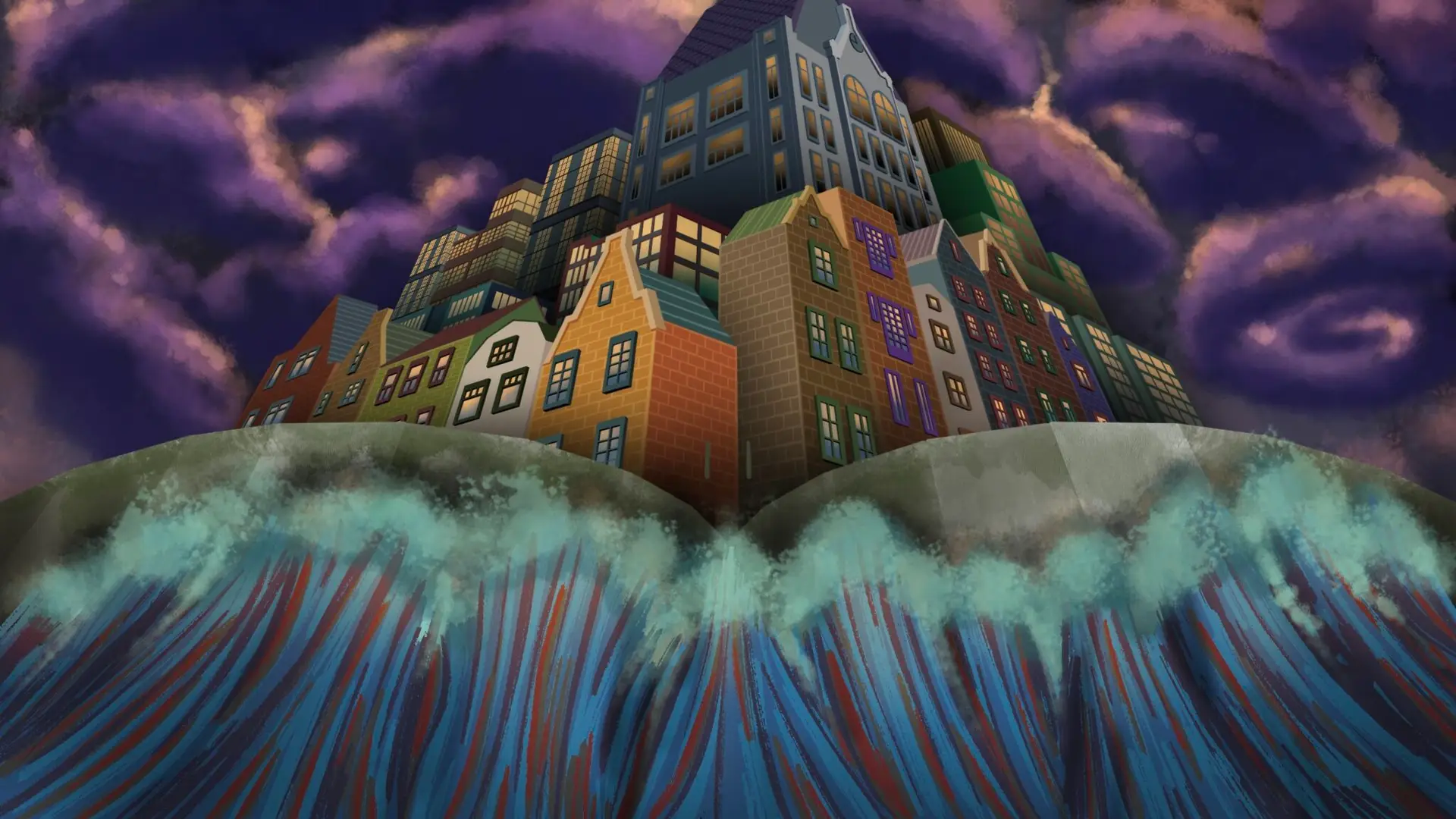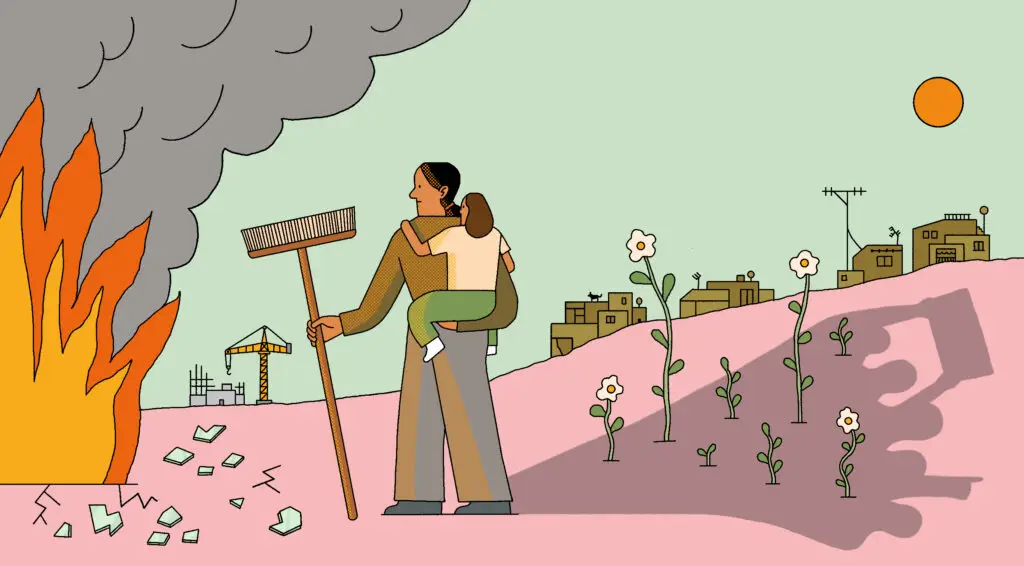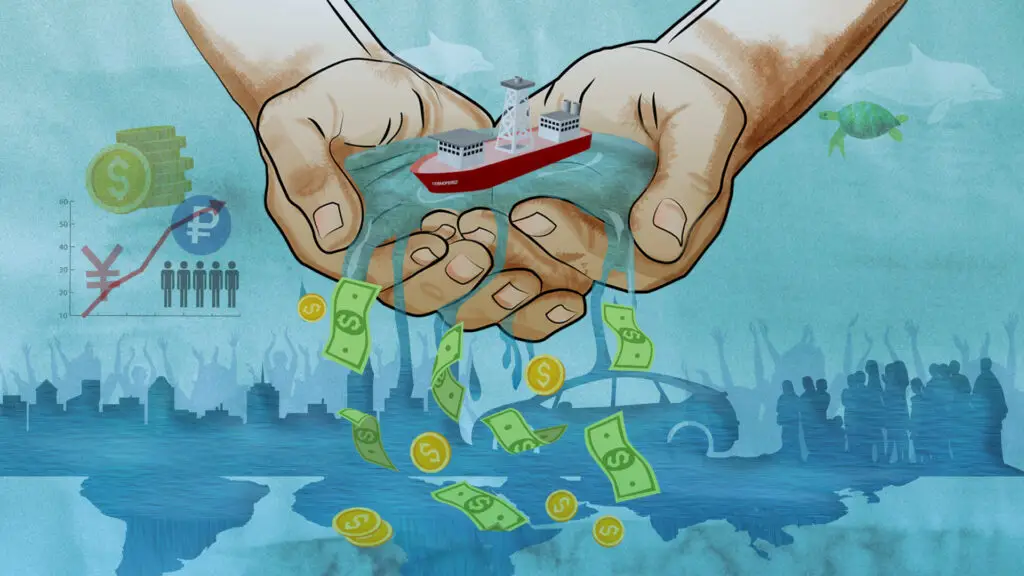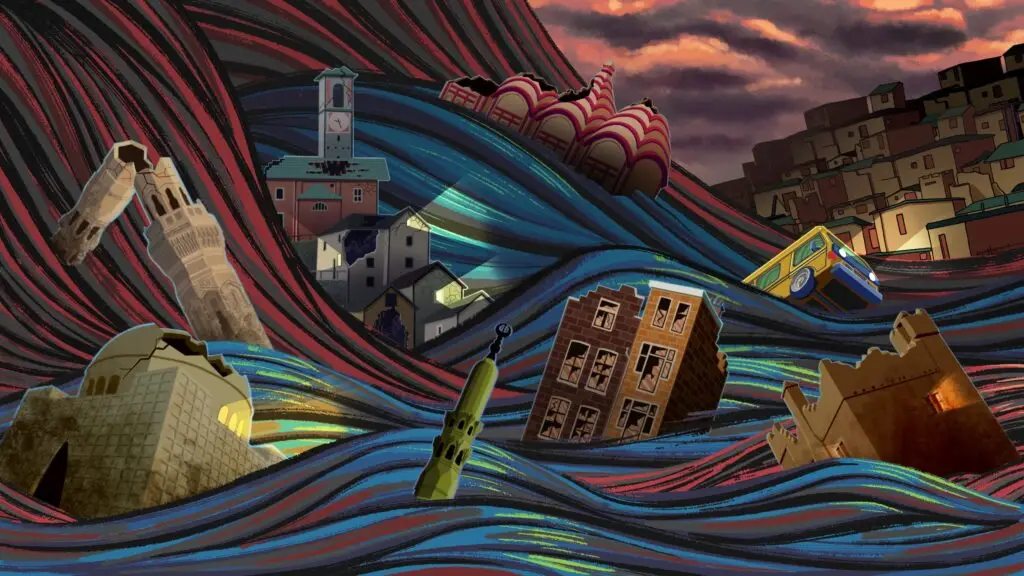Thanks to the city’s efforts toward climate adaptation and decades-old engineering works, Rotterdam does not have to worry about climate change until the end of the century. Yet, as the city develops, any mistake in flood defence planning becomes more costly.
Rotterdam literally means “dam on the Rotte [river]”, celebrating the 13th-century construction that protected the Rotta village from flooding. The city owes its very existence to the sea, starting off as a small fishing settlement and growing into Europe’s – at its peak time, even the world’s – largest seaport.
A liminal city on the verge of 175 nationalities, with more migrants than natives and the world’s highest level of English as a second language, Rotterdam flows with scrupulous business. Everyone is left to do their thing, so the streets surprise the passers-by with the most unusual sights. Like a guy strolling through the busiest party street with an iguana on his arm, Rotterdammers do not let anyone disturb their peace. Yet, the same geography that allowed Rotterdam to develop and flourish is now threatening its survival. Water is all around Rotterdam: the Meuse river cuts the city in half, the screams of seagulls are a constant reminder of the nearby sea, even relaxing in a garden can be an encounter with water that creeps up from the ground.
Rotterdam faces multiple, and multiplying, threats from the changing climate: the newest prediction by The Royal Netherlands Meteorological Institute (KNMI) assumes a sea-level rise of between 30 cm and 1.21 m between 1995 and 2100, depending on the emissions pathway and in line with the IPCC predictions. Already by 2050, the sea will likely rise by 14 – 47 cm. Meanwhile, the sea level already rose by about 20 cm between 1900 and 2018, speeding up in the past decades.
Apart from a heightened risk of coastal flooding, the sea-level rise (SLR) means that the saltwater penetrates deeper inland, threatening agriculture and freshwater supply. The latter will likely become a problem as soon as SLR reaches 35 cm, perhaps even before 2050.
Then, there are extreme weather events already haunting the city. Drought is the flip-side of rainfall, as they balance each other out. Peter Siegmund, climatologist at The Royal Netherlands Meteorological Institute (KNMI), explained that if locally the amount of rain increases, at other places or times it must decrease by about the same amount. “That’s the story behind why we have both drier periods and stronger precipitation,” Siegmund concluded.

For a city in a multiple-river delta, this is terrible news. The Rhine and the Meuse will increasingly dry up in the summer, as happened in 2022, complicating shipments throughout Europe. Yet, their discharge will significantly increase in the winter, bringing about floods. The Dutch desperately catch the slightest glimpses of the sun, leading to hilarious sights when migrants in autumn jackets walk next to “autochthons” in flip-flops and shorts on an April day. For a few years, the summers have been less rainy and drier, making Rotterdammers happy – as long as they do not work in the shipping industry.
Make climate adaptation happen
The combination of risks from the sea, the river, and the location below sea-level means that Rotterdam will struggle to keep up with the changing climate. Simultaneously, centuries of living and experimenting with the water mean that Rotterdam city planners are well-aware of the risks and up for the challenge.
The national and city governments are working in concert to climate-proof Rotterdam, spending significant parts of their budgets on climate adaptation and aiming to mobilize various societal groups to support their cause. “A huge part of the national budget is invested in Rotterdam,” the city mayor Ahmed Aboutaleb asserted to the audience at the Africa Adaption Summit in 2022.
After a long-time of accepting climate adaptation as a necessity for survival, Dutch and Rotterdam authorities are transforming it into opportunities. The city has invested in creating its image as an innovation hub, a place that “makes it happen”. That city-branding effort builds on the attitudes of Rotterdammers – direct, independent, drily sarcastic, and tough. Rotterdam has the highest proportion of self-employed workers in the country. The city asks for neither help nor permission but keeps going.
Adaptation is an element of the innovation narrative, presented as creating jobs and economic growth while future-proofing livelihoods.
The Dutch, especially in and around Rotterdam, come up with new ways to deal with water and export this knowledge abroad. During the Africa Adaptation Summit, mayor Aboutaleb presented Rotterdam as “the living lab of climate adaptation, a showcase to the world”. Floating houses, offices, even farms, green roofs, sponge gardens, all have the double function of protecting and promoting the city.
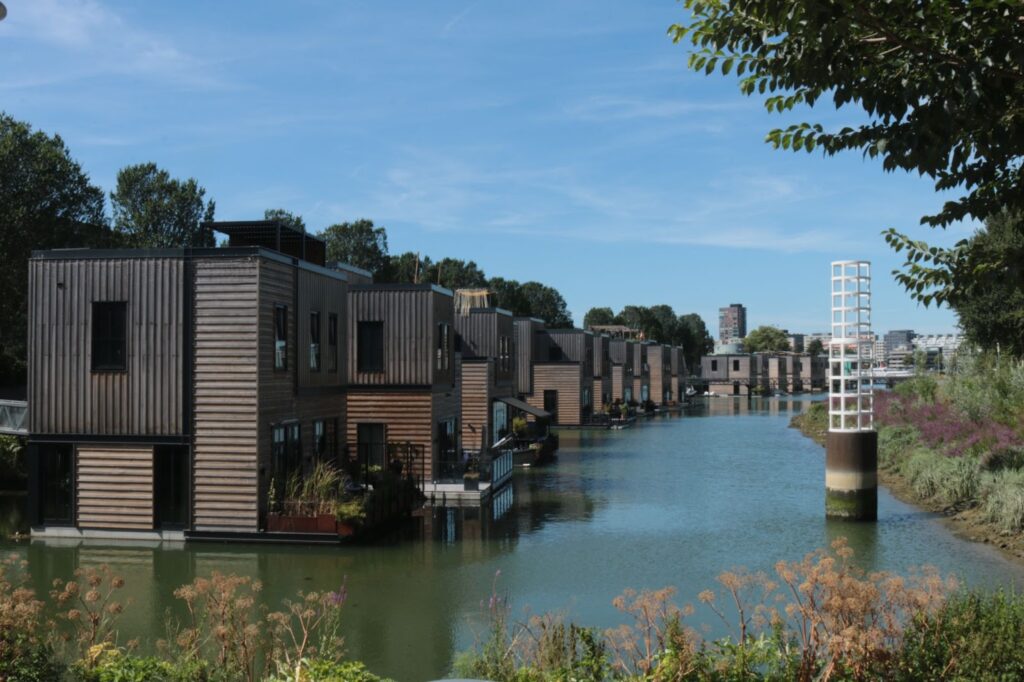
Yet, nobody can know if the adaptation efforts are enough. While the existing and planned measures should be sufficient until at least 2070, too much uncertainty over the progress of climate change remains afterwards to assess whether the city will truly stay liveable. Some assessments suggest that if the sea rises by 5m – an estimate in sight within a century, considering the unpredictability of the rate that Greenland and Antarctica’s glacier will melt – Rotterdam will have no other choice but to relocate.
Why, then, invest so much money into keeping the city, pun intended, afloat? The short answer is money. Zuid-Holland, where Rotterdam lies, generated over 21% of national income in 2021. The Port of Rotterdam alone contributed 3% to the national GDP in 2019. Protecting this area, therefore, pays off. Besides, the human cost of inaction is too high. Zuid-Holland is home to over four million people, a majority of whom cannot be evacuated because the low-lying areas are too deep and large. “Parts of my city lie six metres below sea level. If a dike breaks, I cannot evacuate anyone,” Aboutaleb stated.
The supportive past
The 1953 flood offers a perfect illustration of the mayor’s point: 1800 people died, but the Zuid-Holland province largely escaped the damage – all thanks to the skipper Arie Evegroer. When a dike broke, exposing a low-lying area where around 3 million people lived, he navigated his ship into the crack and blocked the incoming water. The story shows how much the Dutch have tamed the water, but it also underscores the looming dangers.
A year after the floods, the Dutch government established Delta Works, a flood prevention project running until 1997. Due to its combination of key economic value and a very high potential death count, Zuid-Holland was marked as a “key dike area”, where flood defenses had to be significantly stronger than in other parts of the Netherlands. The almost total destruction that Rotterdam suffered from several WW2 bombardments worked for once in the city’s favor, as it allowed city planners to incorporate flood defenses into the reconstruction efforts.

Primary defence dikes (in red/orange) and regional defence dikes (blue lines). Credit: City of Rotterdam, Water Safety
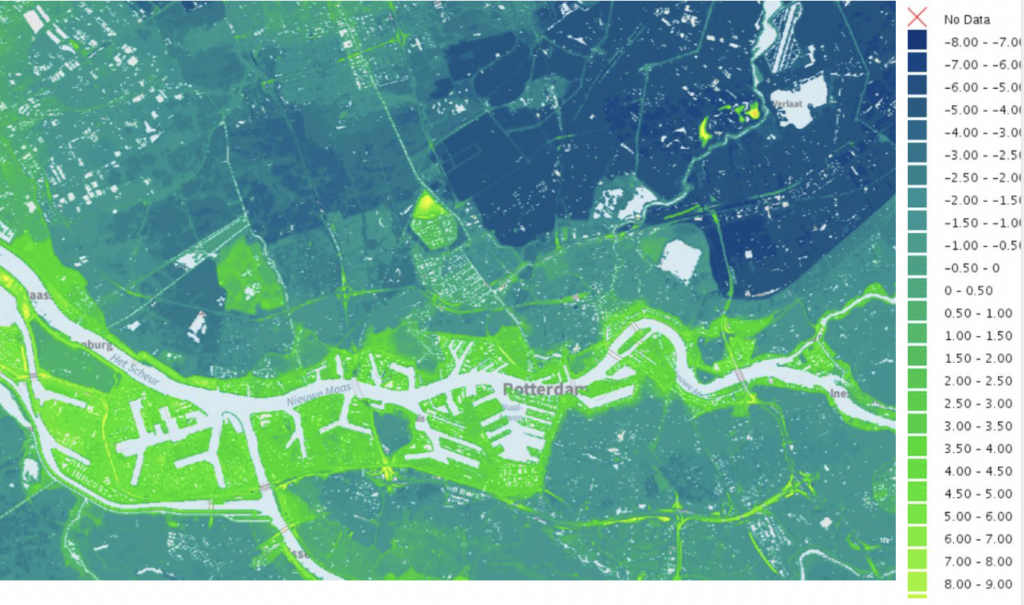
People’s attitudes are the best measure of the flood policy’s success: the Dutch do not see flooding in the Netherlands as a natural phenomenon, assuming that they will be protected. Life in the city goes on regardless of water levels: bikers pass by tokos, small grocery shops, next to designer ceramic shops, shoemakers and stores with traditional clothing, and old-school Rotterdam bars close by bodegas. Diversity increases with the distance from the city centre, by now home only to multinational chain stores.
Rotterdam continues to reap the benefits of being a key protection area. With a 70-year-old focus on prevention, much of the city’s flood defense infrastructure is long in place, leaving the city planners with maintenance and additional constructions. The authority supervising the Delta Works, Delta Program, continues, monitoring the changing climatic situation and issuing yearly updates.
The costs remain remarkable. The measures are financed from the Delta Fund, a budget separate from the central governmental one. So far, an average of €1.25 billion a year has been earmarked until 2032, split between investing in new measures (55%) and maintenance (45%). The Program estimates that implementing the recommendations until 2050 will cost the country €1.2 to €1.6 billion per year, and €0.9 to 1.5 €billion yearly between 2050–2100.
Keeping the water out
Dikes undergo regular check-ups to see whether their maintenance complies with standards. That a certain spot is a dike is hardly obvious to the untrained eye, as they blend into the urban landscape. Many are roads, some have parks built on top. In Dakpark, a dike park in Rotterdam West, the authorities need to control the number of rabbits as their cavities cut through the dike’s foundations.
The responsibility for dike maintenance lies with a uniquely Dutch structure: water boards (waterschappen). They date back to the country’s beginnings when they governed the newly created water systems. Today, waterboards work together with municipalities and water utility companies. Rotterdam has three waterboards, divided per water basin.
Jurgen Bals, area manager for Rotterdam at the Water Board of Schieland and Krimpenerwaard (Hoogheemraadschap van Schieland en de Krimpenerwaard), which manages Rotterdam’s North, East, and city centre, explained: “In Rotterdam, the dikes are up to standards. We monitor the sea level rise and make plans to strengthen dikes if they don’t meet future (2050) requirements. It is a normal procedure every six years.”
As it needs to be kept safe, the city’s landscape is highly regulated, and not only so in perfectly maintained canals and parks. Graffiti is illegal except for designated spots, turning it into mere murals, aesthetically pleasing but without an edge. Only when looking out the metro windows in dark tunnels can a passenger still spot visual disruptions.
Any space outside the dike lies at least 3 m above sea level. Rotterdam has the greatest number of inhabitants that live and work outside dikes nationwide. The outside-dike areas reflect the city’s more-or-less equal wealth distribution. Although some city parts have been, and remained, traditionally more wealthy (and white), Rotterdam does not segregate the rich and the poor. The yearly influx of international students, taking up whatever they can find, further equalizes the city.
Similarly, the outside-dike areas are a mix of wealthy and poorer neighbourhoods. Some of them have been undergoing intense development, reflecting the city’s confidence in its flood protection systems. For example, Kop Van Zuid became a skyscraper hotspot, hosting many multinational companies, within a few years.
Floating protection
Dikes, however, are just the first part of Rotterdam’s flood prevention system. The water managers actively ensure that the sea does not enter the coastline too much. They have been strengthening the beaches with sand dug out of the North Sea since 1990. The Delta Programme expects beach nourishments to function at least until the end of the century, considering how much sand the seabed still holds. The project is likely to cost €0.1 to €0.3 billion yearly until 2100.
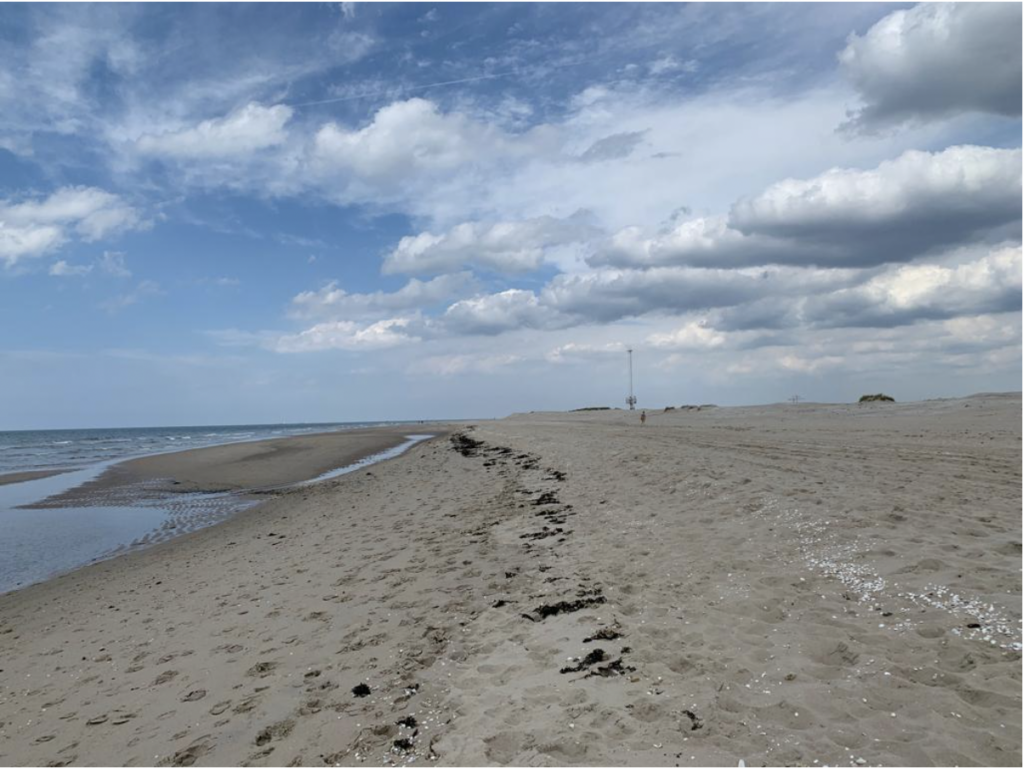
Finally, if the sea tide rises too high, the Ministry of Infrastructure and Water Management (Rijkswaterstaat) can just close off the Meuse river to prevent the waves from entering Rotterdam. The Maeslant Barrier, constructed during the Delta Works for almost half a billion EUR, is a 420-meter-long, movable storm surge barrier located right before the Meuse river reaches the North Sea. It stays open to allow shipping into the Port of Rotterdam. A computer system constantly monitors the water height in Rotterdam’s city center. If the tide rises to 3m, the barrier closes.
The Maeslant Barrier is the pearl in Rotterdam’s climate adaptation crown. Foreign delegations visit the Keringhuis, an education institution by the barrier, so regularly that there is a small exhibit dedicated to the gifts they bring.
“Whenever a natural disaster strikes somewhere, we receive that country’s delegation the following week,” Jeroen Kramer, a communications officer at the Keringhuis, explained.
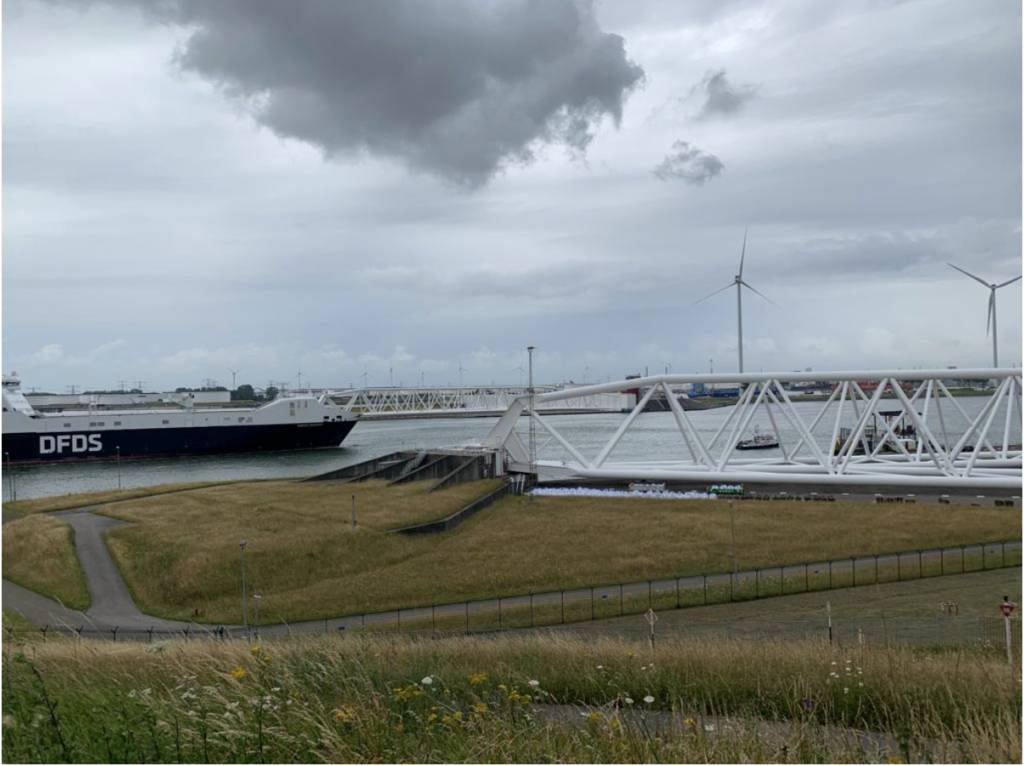
The barrier seems fully thought-through. Closing during heavy rains raises fears of a “bowl effect”: the increased river discharge could not be unloaded into the sea and the city would get flooded anyway, from the river. Kramer explains that this risk is very low, as the barrier can open during lower tide to release the river discharge. If the storm forces a longer closure – 24 or 30 hours – the engineers can pump the excess discharge from the Maas and store it in the Volkerak lake. The dikes around the lake are – you guessed it – reinforced.
Ordinary Rotterdammers do not occupy themselves with the barrier, perhaps they do not even know it is there. Busy creating their place in the city, they ride their bikes to work in elegant outfits and high heels, stroll the streets in pyjamas on lazy days, and hang out in spots varying per culture: the corners, cafes, in front of their houses or shops. They are respectfully unbothered by others.
Yet, very few countries, especially in the Global South, could afford similar protection. The construction of the barrier ran from 1991 to 1997 and costed 450 milion EUR (approx. €738 million EUR today), a value close to 0.105% of the Dutch GDP in 1997. For example, these costs would constitute 1.1% of Bangladesh’s 1997 GDP. That same year, Bangladesh spent 4.9% of its GDP on all government expenditures (services, goods, and employees’ salaries).
The Maeslant Barrier can protect Rotterdam from storm surges at least until 2070. The key issue with the barrier is not its height but whether it can withstand closing more often. So far, the tide has never reached 3m in Rotterdam, and the barrier has only ever closed for testing. Experts estimate, however, that SLR of 85 cm – so 65 cm from now – would cause the barrier to close yearly.
The big six of climate resilience
Climate change is not sea-level rise alone, and Rotterdam knows this well. The municipal program for climate adaptation, Rotterdam WeatherWise (Rotterdams Weerwoord), outlines five other key climate challenges the city faces: rainfall, groundwater, land subsidence, drought, and heat. The city spearheads an effort to climate-proof the city, trying to activate various societal groups, from housing associations and citizen foundations to private homeowners, for collaboration – the Dutch way of policymaking.
Through Rotterdam Weatherwise, the city sets to improve several, not only climatic, aspects at once. “We are not only focusing on climate adaptation but first try to understand what is important for the people,” Tim de Waele, advisor on Water, Participation, and Climate Adaptation at the City of Rotterdam outlined. “If citizens want a new playground, for example, maybe we can additionally make it greener, store water, create shadow.”
“A lot of times, people just want to have it gezellig [a very Dutch idiom, translating into cozy, fun, pleasant]. They green their gardens, for example, because they want to meet each other. If you make it about climate adaptation, I think many people will not join. But if you explain that you are trying to make it more gezellig, several more people participate.”
Such practical pragmatism is at the heart of Rotterdam’s climate adaptation efforts, making them not only more efficient but also more profitable. Protect the city by connecting to what people care about – that’s the recipe for the no-nonsense, Rotterdam-style adaptation.
“We are very lucky that we have a lot of technical expertise and a lot of satellite data that we use,” Rosemarie van Ham, the founder of Inclusive Climate Action Rotterdam (ICAR), stated. “Gathering citizens, private organisations, housing associations, social organisations, and various departments of the municipality, ICAR creates space to focus more on the social aspects alongside the technical ones to create an equitable climate policy.”
In 2020, Rotterdam dedicated €3.5 billion to climate adaptation, out of which €76 million went for water management and €2.5 million to Rotterdam WeatherWise.
When solutions work too well
Rotterdam’s readiness to deal with water sometimes backfires. The city has been dealing with excess groundwater for decades. Pumping the water out to prevent wet gardens and overflooded basements has become the norm. Yet, this norm is now proving problematic.
Parts of Rotterdam, especially Rotterdam North, are built on a swamp, which means that the land below them is sinking. Sinking land combined with low groundwater levels during increasingly frequent droughts expose wooden foundation poles, which are supposed to always stay underwater. Many Rotterdam houses built before 1980 have such foundations. When the wood comes into contact with air, it starts rotting. The issue is easy to spot from the outside, as cracks appear on the wall or doors cannot close properly anymore.
“Almost all foundations in the Oude Noorden area are broken,“ Piet Vollaard, architect and co-founder of urban commons initiative City in the Making (Stad in de Maak), explained. “With heavy rainfall, these low-lying areas can’t cope.”
The issue is considerable as 30,000 houses – about a fourth of Rotterdam – are at risk of foundation troubles. And the housing is only getting scarcer.
Housing Shortage
The city looks for ways to combine urban development with climate adaptation. In 2021, the municipality introduced a directive that every new Rotterdam building has to store at least 50 mm of rainwater per square metre.
Efficient use of space is key as Rotterdam grapples with a housing shortage alongside the climate crisis.
With a population of 655,468 in December 2021, Rotterdam may seem small, but the city is facing an acute scarcity of houses. Much of the shortage has to do with the housing crisis gripping the big Dutch cities. Property investors are allowed to dictate the prices, leading them to skyrocket.
The housing shortage makes the city’s climate agenda ever more pressing. As the land becomes scarce, developments in flood-prone zones increase. In the past century, urban areas in flood-prone parts of the Netherlands increased six-fold, leading to a great increase in potential flood damage.
By 2100, urban areas in flood-prone zones will increase up to 125% as compared with 2000 levels. Already by 2040, the economic damage in case of a flood will be 250% higher than in 2000. While the country’s ability to deal with floods has also been increasing, the ongoing developments mean that any mistake in flood defence planning will get more and more costly.
Bals explained that to heighten dikes, they also need to be widened, which can increase pressure on the already scarce urban areas. Besides, while in theory, it is possible to significantly heighten and widen the dikes, the low-lying area behind the dike gets deeper, allowing for no mistakes. If such a dike would break, it would reveal an area too low-lying across too wide stretches of land for the inhabitants to evacuate. The area would essentially become, per Rotterdam’s black humour, “De Put” – a well. The Dutch prevention paradigm leaves no space for another Arie Evegroer to close the dike with a ship.
Fossil fuel-sponsored climate adaptation
For all the city’s successes, there is irony in Rotterdam’s adaptation efforts.
The Port of Rotterdam is an important source of employment for Rotterdammers: according to Aboutaleb, over 150,000 people work there. It is also a crucial source of municipal and government funds. The City of Rotterdam holds 70% of the port’s shares, with the remaining 30% belonging to the national government. In 2015, the city received €63.2 million as a dividend.
The harbour contains five oil refineries and a large coal-fired power plant. It alone is responsible for 20% of all Dutch, and a staggering 90% of Rotterdam’s, emissions. That is a lot in a country with per capita emissions reaching 8.06 t in 2020, almost 13 times higher than Bangladesh or Nigeria’s. Despite setting ambitious climate targets, the Dutch government has trouble keeping up with its promises. In 2021, the Dutch Environmental Assessment Agency showed that the country will not meet its target of 49% greenhouse gas reduction by 2030.
Climatologist Peter Siegmund highlighted that although some future SLR cannot be stopped by now, the final rise will depend on how much carbon dioxide we will continue emitting. The emissions impact how fast the ice in Antarctica and Greenland melts. “In the long run, the difference in SLR between doing nothing about greenhouse gas emissions and complying with the Paris Climate Agreement becomes very large,” concludes KNMI in its latest Climate Signal (KlimaatSignaal’21)that includes the country’s most up-to-date SLR predictions.
Following the “frog in the pot” metaphor, Rotterdam is boiling its own water while putting on a heat-resistant layer.

